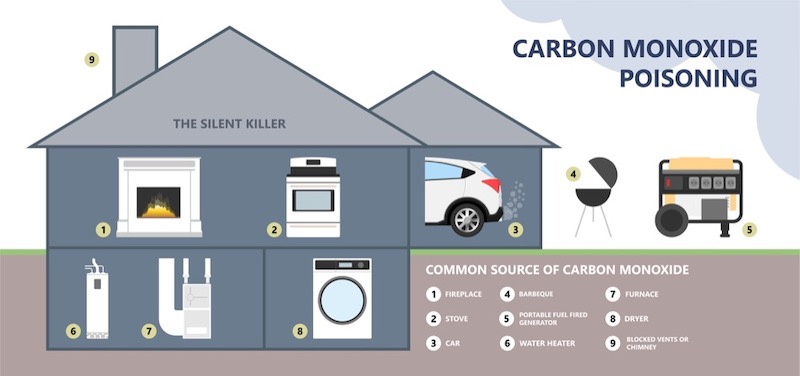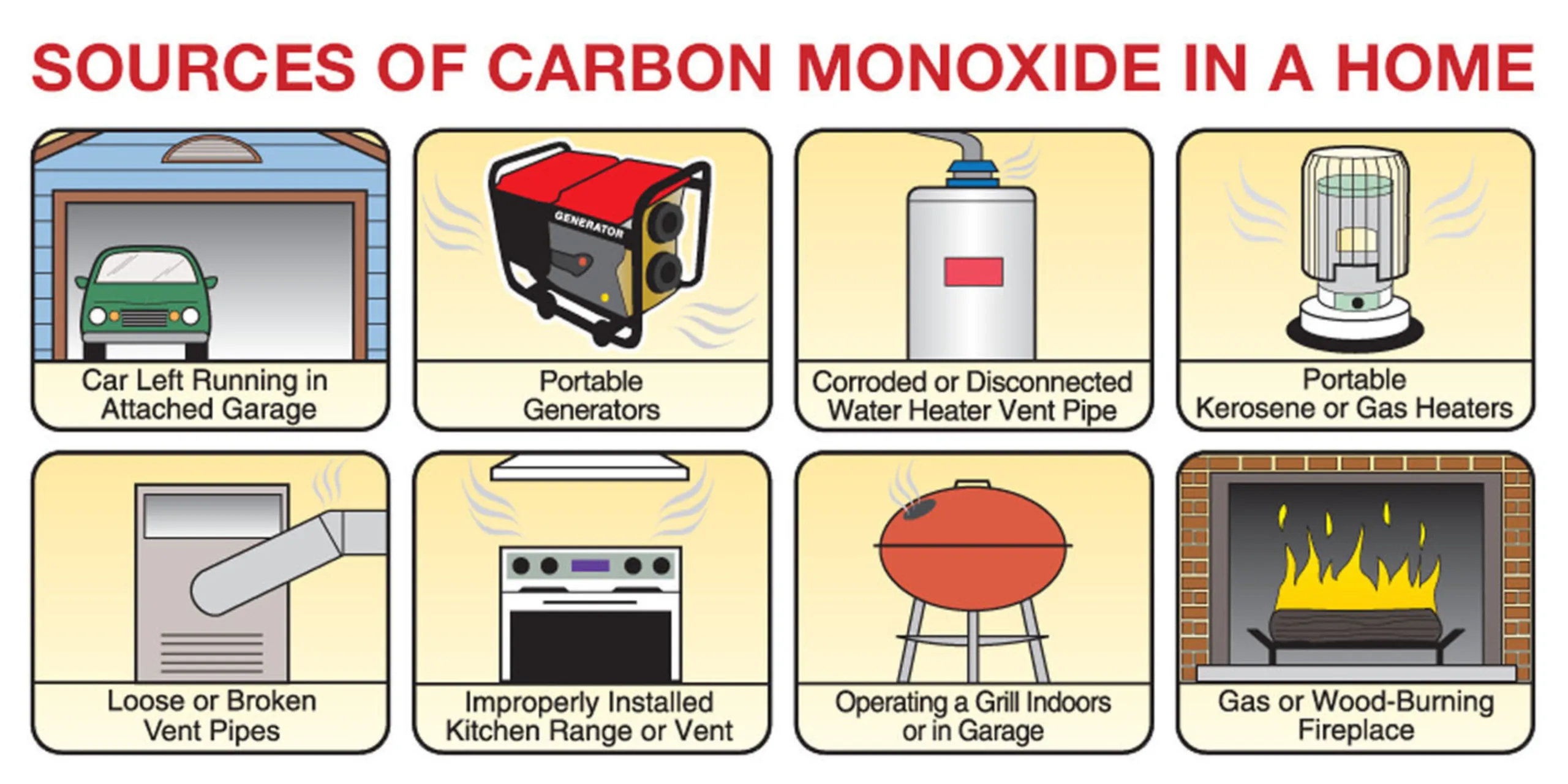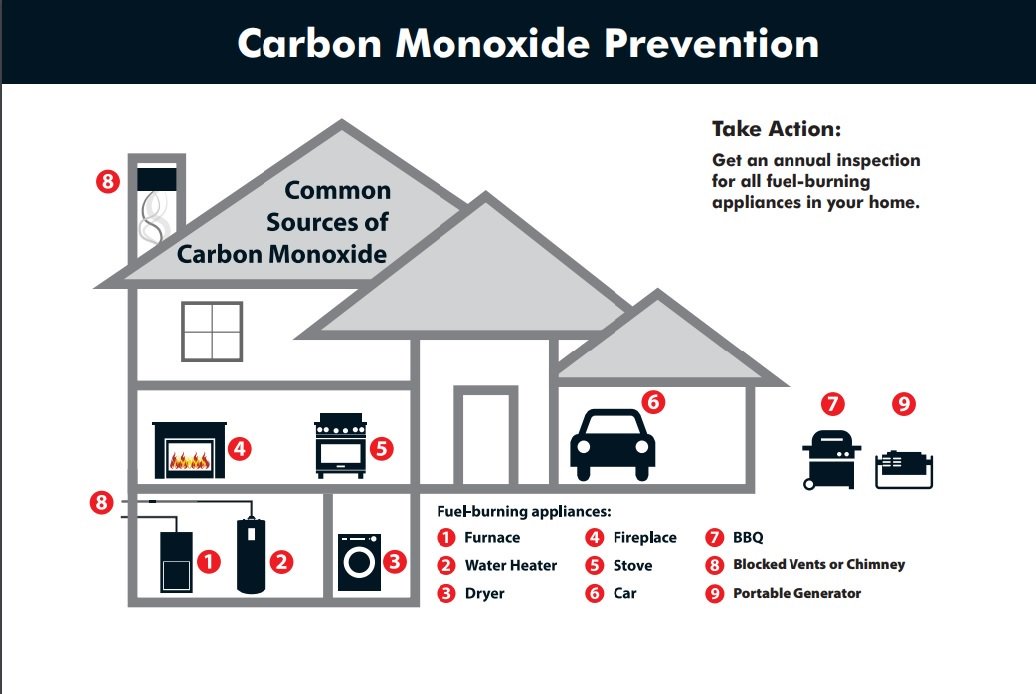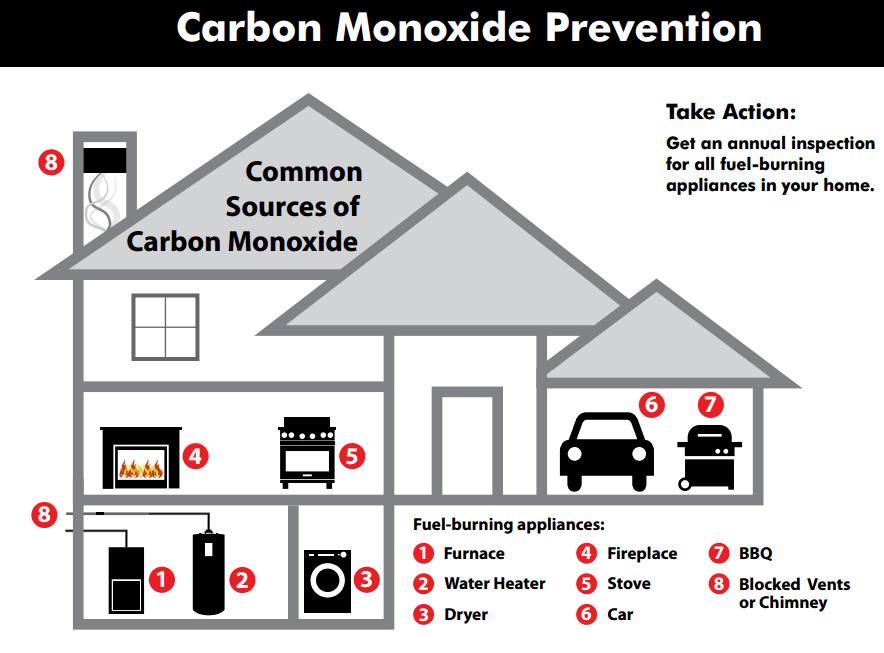What Releases Carbon Monoxide In A House

A silent and invisible danger lurks in many homes: carbon monoxide (CO). This odorless, colorless gas can be deadly, and its presence often goes unnoticed until it's too late. The good news is, by understanding the common causes and knowing how to troubleshoot them, you can significantly reduce the risk of CO poisoning in your home.
This article will guide you through a step-by-step process to identify potential sources of carbon monoxide and offer some simple DIY fixes. Remember, your safety is paramount. If at any point you feel unsure or the problem seems beyond your capabilities, call a qualified professional immediately.
Understanding the Culprits: Common CO Sources
Carbon monoxide is produced by the incomplete burning of fuels. Any appliance that burns fuel, whether it's natural gas, propane, oil, wood, or kerosene, has the potential to produce CO. Here's a breakdown of the most common offenders:
- Furnaces: The primary heating source in many homes, a malfunctioning furnace is a frequent cause of CO leaks.
- Water Heaters: Gas or propane water heaters, especially older models, can produce CO if not properly maintained.
- Fireplaces (Wood-burning and Gas): Improper ventilation or a blocked chimney can cause CO to back up into the house.
- Gas Stoves and Ovens: While designed to burn fuel efficiently, these appliances can produce CO if burners are clogged or the oven isn't venting properly.
- Portable Generators: Never operate a portable generator inside a home, garage, or shed. These are designed for outdoor use only.
- Cars and Trucks: Running a vehicle inside a garage, even with the door open, can quickly lead to dangerous CO levels.
- Space Heaters (Kerosene and Propane): These heaters, while convenient, require proper ventilation and can be a significant source of CO if used incorrectly.
Step 1: Check Your Carbon Monoxide Detectors
This is the most crucial step. Ensure you have working CO detectors on every level of your home, especially near sleeping areas. Test them monthly by pressing the "test" button. If the detector doesn't sound, replace the batteries immediately. Replace CO detectors every 5-7 years, as their sensors degrade over time. Note the expiration date on the detector itself. If you don't have CO detectors, install them immediately.
If your CO detector is sounding, evacuate the house immediately and call 911. Don't try to troubleshoot the problem yourself until the fire department or other emergency responders have cleared the house.
Step 2: Inspect Your Furnace
A faulty furnace is a leading cause of CO leaks. Here’s what to look for:
Visual Inspection:
- Rust or Soot: Check for rust or soot around the furnace, especially near the flue pipe (the pipe that vents exhaust outside). This can indicate a problem with combustion or ventilation.
- Damaged Flue Pipe: Inspect the flue pipe for any cracks, holes, or disconnections. A damaged flue pipe can allow CO to leak into your home.
- Yellow or Orange Flame: The flame in your furnace should be blue. A yellow or orange flame indicates incomplete combustion and a potential CO issue. (Note: Observing the flame typically requires removing an access panel – consult your furnace manual for safe access instructions.)
DIY Fixes:
- Replace Air Filter: A dirty air filter can restrict airflow and cause the furnace to work harder, leading to incomplete combustion. Replace the air filter regularly (usually every 1-3 months).
- Check Flue Pipe Connections: If you notice a loose connection on the flue pipe, carefully reattach it. Use aluminum foil tape specifically designed for HVAC systems to seal any gaps.
When to Call a Professional:
- Rust or Soot Present: This indicates a more serious problem requiring professional cleaning and inspection.
- Damaged Flue Pipe (Beyond Simple Connection): If the flue pipe is cracked, corroded, or significantly damaged, it needs to be replaced by a qualified HVAC technician.
- Yellow or Orange Flame: This is a sign of a serious combustion problem that requires professional adjustment.
- You are uncomfortable or unfamiliar with your furnace
Step 3: Examine Your Water Heater
Like furnaces, gas or propane water heaters can produce CO. Check these areas:
Visual Inspection:
- Rust or Soot: Look for rust or soot around the water heater, especially near the vent.
- Vent Pipe Condition: Inspect the vent pipe (similar to the furnace flue pipe) for any damage or blockages.
- Flame Color: Check the flame color (usually visible through an access panel). It should be blue, not yellow or orange.
DIY Fixes:
- Clear Debris Around the Base: Make sure there is no combustible material stored near the water heater.
- Check Vent Pipe Connections: Ensure the vent pipe is securely connected to the water heater and the vent.
When to Call a Professional:
- Rust or Soot Present: This suggests a combustion or venting issue that needs professional attention.
- Damaged Vent Pipe: Similar to the furnace, a damaged vent pipe needs professional replacement.
- Yellow or Orange Flame: This indicates a combustion problem requiring professional adjustment.
- Pilot Light Issues: If you are unfamiliar with relighting a pilot light, call a professional.
Step 4: Inspect Your Fireplace
Both wood-burning and gas fireplaces can be sources of CO if not properly maintained.
Visual Inspection:
- Chimney Blockage: Check for any obstructions in the chimney, such as bird nests, leaves, or debris. This is especially important for wood-burning fireplaces.
- Damper Operation: Ensure the damper opens and closes smoothly. A closed damper while the fireplace is in use will force CO into your home.
- Gas Fireplace Pilot Light: Check the pilot light. A flickering or weak flame can indicate a problem.
- Soot Buildup: Excessive soot buildup inside the firebox indicates incomplete combustion.
DIY Fixes:
- Open the Damper Before Lighting: This seems obvious, but it's crucial. Double-check before starting a fire.
- Clean the Firebox: Remove ashes and debris from the firebox regularly.
When to Call a Professional:
- Chimney Blockage: Have the chimney professionally cleaned and inspected annually, especially if you use your fireplace frequently.
- Damper Problems: If the damper is stuck or damaged, a professional can repair or replace it.
- Gas Fireplace Pilot Light Issues: If you have trouble relighting the pilot light or if it continues to go out, call a qualified technician.
- Excessive Soot Buildup: A professional chimney sweep can remove the soot and inspect for underlying problems.
Step 5: Check Gas Stoves and Ovens
While less common than other appliances, gas stoves and ovens can still produce CO.
Visual Inspection:
- Flame Color: The flames on the burners should be blue. Yellow or orange flames indicate incomplete combustion.
- Burner Clogging: Check for any debris or food particles clogging the burner ports.
DIY Fixes:
- Clean Burners: Carefully clean the burner ports with a small brush or needle to remove any blockages. Turn off the gas supply before cleaning.
- Ensure Proper Ventilation: Use the range hood fan when cooking to help vent fumes outside.
When to Call a Professional:
- Yellow or Orange Flames (After Cleaning): This indicates a more serious problem with the gas supply or burner that requires professional attention.
- Gas Odor: If you smell gas, even faintly, leave the house immediately and call the gas company.
Step 6: Be Mindful of Portable Generators and Other Fuel-Burning Equipment
This is extremely important!
- Never Run a Generator Indoors: Portable generators produce a significant amount of CO. Always operate them outdoors, at least 20 feet away from any doors, windows, or vents.
- Proper Ventilation for Space Heaters: If using a kerosene or propane space heater, ensure adequate ventilation by opening a window slightly. Never use these heaters in enclosed spaces.
- Vehicle Exhaust: Never run a vehicle inside a garage, even with the door open. CO can build up quickly.
Prevention is Key: Regular Maintenance Matters
The best way to prevent CO poisoning is to maintain your appliances properly. Schedule annual inspections and tune-ups for your furnace, water heater, and fireplace by qualified professionals. These inspections can identify potential problems before they become dangerous.
Here are some additional tips:
- Install and Maintain CO Detectors: As mentioned earlier, this is the most important step.
- Never Use a Gas Oven to Heat Your Home: This is a dangerous practice that can lead to CO poisoning.
- Be Aware of Symptoms: Learn the symptoms of CO poisoning, which include headache, dizziness, nausea, vomiting, confusion, and loss of consciousness. If you suspect CO poisoning, get fresh air immediately and seek medical attention.
Empowering Yourself: Staying Safe
Troubleshooting potential CO sources in your home can feel daunting, but by following these steps and exercising caution, you can significantly reduce the risk of CO poisoning. Remember, when in doubt, always call a professional. Your health and safety are worth it.
By being proactive and informed, you can protect yourself and your family from the dangers of carbon monoxide and enjoy a safe and healthy home environment.










